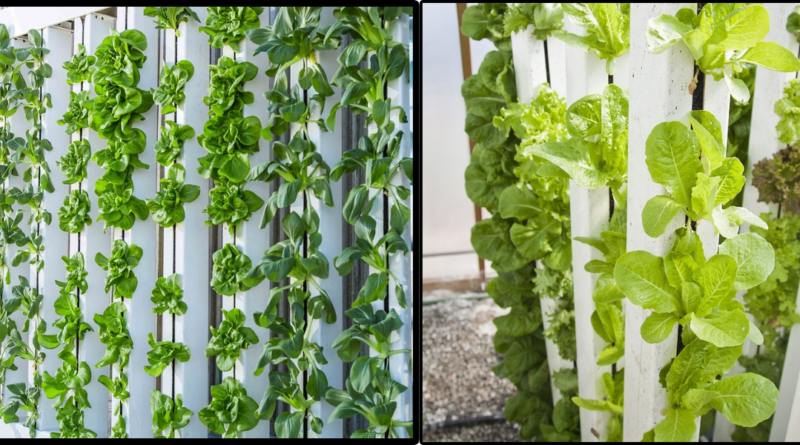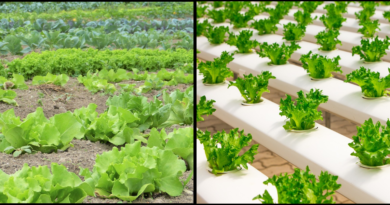Vertical Farming: Challenges and Sustainable Future

Introduction:
Vertical farming, a concept that challenges the horizontal expanse of traditional cultivation, has emerged as a beacon of innovation in the realm of sustainable food production. Since cutting-edge technology has been integrated, urban agriculture has experienced a spectacular revolution. Vertical farming, which stacks crops on surfaces that are inclined vertically to circumvent conventional agricultural conventions, is one of the most innovative developments in this field. This article examines how vertical farming is changing the face of urban agriculture as a result of technology.
The Rise of Vertical Farming:
Growing in popularity as a cutting-edge response to the problems with traditional agriculture in urban environments is vertical farming. There has never been a greater need for sustainable and effective food production techniques due to the world’s population growth and decreasing arable land. By using vertical space to plant crops in stacked layers or on surfaces that are vertically inclined, vertical farming allays these worries.
Technological Integration in Vertical Farming:
The key to vertical farming’s effectiveness and profitability is the smooth integration of cutting-edge technology, each of which improves the cultivation of crops in a vertical environment. The following are the main technological factors supporting the development of vertical farming:
Hydroponics and Aeroponics:

Vertical farming incorporates soilless growing techniques, leading the way in hydroponichttps://en.wikipedia.org/wiki/Hydroponics and aeroponic systems. In aeroponics, plant roots are suspended in the air and nutrients are provided by a mist, whereas in hydroponics, plants are grown in nutrient-rich water. Comparing these techniques to traditional soil-based techniques, they improve resource efficiency by promoting rapid and strong plant development.
LED Lighting Systems:
Vertical farming relies significantly on artificial illumination, particularly in areas with little access to natural sunshine. Because of their energy efficiency and capacity to emit precise light spectrums necessary for photosynthesis, LED lighting systems have become vital. Customized LED systems guarantee that crops, independent of outside influences, develop under ideal conditions of light for the duration of their growth cycle.
Smart Automation:
Vertical farming is changing rapidly with the use of intelligent technology. Automated systems constantly monitor and control environmental factors, including temperature, humidity, and nutrient levels, through the use of a network of sensors and actuators. With this real-time management, physical intervention is minimized and efficiency is maximized as crops bloom with conditions adapted to their individual needs.
Vertical Farming Software:
There are now specialized software programs available to make managing vertical farms easier. Crop planning, resource allocation, and inventory management are made easier by these systems. These software solutions increase operational efficiency and add to the overall success of the farming endeavor by offering a single hub for monitoring and controlling many parts of a vertical farming operation.
Data analytics and AI:
Vertical farming is fundamentally based on data-driven decision-making. Vast information produced by sensors and monitoring systems are analyzed to provide insights into plant behavior, growth patterns, and environmental conditions through the combination of data analytics and artificial intelligence (AI). With the help of AI algorithms, farmers may maximize productivity by making well-informed judgments about the best agricultural practices.
Remote Monitoring and Control:
Vertical farms may be continuously monitored and maintained because of developments in communication technology. Farmers with an internet connection may view real-time data, change settings, and resolve problems from any location. Its capacity to respond quickly to unanticipated obstacles lowers downtime and possible crop losses while also improving operational flexibility.
Blockchain for Traceability and Transparency:
A layer of traceability and transparency is added to the vertical farming ecosystem through the incorporation of blockchain technology. BLOCKCHAIN REVOLUTION: Organic Agriculture Transparency Through the use of an unchangeable ledger to document each step of the supply chain, from planting to shipment, stakeholders can confirm the source and quality of the food. This helps with quality assurance and compliance, in addition to boosting customer trust.
Environmental Sensors for Precision Agriculture:
In vertical farming, environmental monitoring is more than just basic maintenance. By using specialized sensors to assess things like CO2 levels, soil composition, and even indications of plant health, precision agriculture may be accomplished. Vertical farms are able to minimize their environmental impact and maximize resource consumption by carefully customizing the growth conditions to meet the specific requirements of each crop.
Water Recycling and Closed-Loop Systems:
Vertical farming incorporates water recycling devices to alleviate the worldwide issue of water scarcity. Irrigation systems with closed loops gather and purify runoff water, then recycle it continuously. This reduces the environmental impact of traditional farming methods while also conserving water supplies.
Energy-Efficient Climate Control:
Because vertical farms are common in urban settings with limited space, energy efficiency is an important factor to take into account. With the use of real-time data, advanced climate control systems optimize energy use by regulating humidity, temperature, and lighting. This lowers operating expenses while advancing sustainability objectives.
Integration of Genetic Engineering and Breeding Techniques:
The efficient use of crop properties for vertical farming is mostly dependent on genetic engineering and modern breeding techniques. Agronomists and scientists strive to develop crops with characteristics like greater disease resistance, quicker development, and higher profits that are especially suited for indoor farming.
A ray of hope for overcoming the difficulties in contemporary food production is vertical farming, a tribute to the combination of agriculture and technology. In addition to optimizing space use, the complex combination of hydroponics, LED lighting, automation, data analytics, and a variety of cutting-edge technologies also promotes sustainability and resource efficiency. The potential of vertical farming, which offers a dynamic response to the urgent problems facing urban agriculture and portends a time when fresh, locally grown fruit is not just accessible but also a sustainable reality, grows as the technology landscape develops.
Environmental sustainability of vertical farming:
With its creative methods of growing, vertical farming not only solves the problems associated with urban agriculture but also becomes a major force in advancing environmental sustainability. This innovative approach to indoor crop cultivation has a number of environmental advantages that will help create a future that is more resource- and eco-conscious.
Reduced land footprint:
The capacity of vertical farming to optimize space usage is among its most important contributions to environmental sustainability. Large tracts of land are needed for traditional agriculture, which frequently results in habitat degradation and deforestation. Vertical farms, on the other hand, reduce the requirement for vast amounts of land by stacking crops vertically. This decrease in land usage contributes to the preservation of biodiversity and natural habitats.
Water Conservation through Precision Agriculture:
In vertical farms, hydroponic and aeroponic technologies use much less water than conventional soil-based techniques. Closed-loop irrigation systems also recycle and reuse water, reducing the total demand for this valuable resource and lessening the negative effects of water shortages on the environment.
Minimized Dependency on Pesticides and Herbicides:
Chemical pesticides and herbicides are not as necessary in vertical farms since their regulated environment acts as a natural defense against illnesses and pests. This helps to produce cleaner, pesticide-free crops while also reducing the environmental damage that comes with conventional agricultural methods.
Energy-Efficient Technologies:
Energy-efficient technologies are used by vertical farms to generate ideal growth conditions, such as temperature control systems and LED lighting systems. Accurate management of the environment saves energy while optimizing agricultural output. This energy efficiency lowers the carbon footprint https://en.wikipedia.org/wiki/Carbon_footprint connected to food production, in line with sustainable practices.
Localized food production and distribution:
By carefully planning their locations in cities, vertical farms may bring food production closer to the customer. Produce delivery across large distances emits fewer greenhouse gases thanks to this targeted strategy. Vertical farming helps to create a more robust and sustainable food supply chain by growing crops in or close to urban areas.
Year-Round Crop Production:
Vertical farms allow for year-round food production regardless of the outside weather because of their regulated interior environment. The necessity for seasonal crop rotation and the transportation of crops from other regions is decreased by this continuous cultivation. It makes sure that there is a regular and reliable supply of fresh produce, which helps to create a more stable and sustainable food system.
Potential for Storing Carbon
Facilities for vertical farming may be planned with sustainability in mind by utilizing elements like rooftop gardens, green walls, and carbon capture technology. By aiding in the storage of carbon, these programs help reduce the greenhouse gas emissions brought on by human activity. As urban green areas, vertical farms may improve the quality of the air and the environment as a whole.
Integration of Renewable Energy Sources:
Forward-thinking Vertical farms explore the integration of renewable energy sources, such as solar panels and wind turbines, to power their operations. By switching to clean energy, we can lessen our dependency on traditional power systems and lessen the environmental damage that comes with agricultural energy use.
One of the most innovative approaches to ecologically sustainable agriculture is vertical farming. Vertical farming enhances the resilience and environmental consciousness of the food production system by mitigating the negative effects of traditional farming, maximizing resource use, and minimizing the ecological imprint. The prospect for even more environmental sustainability in vertical farming looks more and more intriguing as technology develops.
Challenges and Future Prospects:
Even though vertical farming has the potential to completely transform agriculture, there are still difficulties involved. Comprehending and resolving these challenges is essential to the sustained development and prosperity of this inventive agricultural technique. Furthermore, investigating the prospects and possible developments in vertical farming illuminates the fascinating opportunities that await.
Challenges:
Capital Investment Barriers:
A vertical farm requires large early expenditures in technology, infrastructure, and specialized machinery. For smaller-scale or prospective farmers in particular, getting beyond the financial barrier of high initial expenses continues to be a major difficulty.
Energy Consumption Challenges:
For lighting, heating, and cooling systems, a steady energy supply is necessary in the regulated environment that is vital to vertical farming. Energy-efficient technology has advanced, but finding and maintaining sustainable energy solutions is still a difficult task.
Workforce Skill Requirements:
The labor needed to operate and maintain a vertical farm must possess specific skills in automation, data analytics, and agricultural technology. It may be difficult to find and keep qualified workers, especially in this ever-changing business.
Effective Waste Management:
Waste from vertical farming systems includes leftover plant material and nutritional solutions. To reduce environmental effects and guarantee the long-term viability of vertical farms, effective waste management techniques must be established.
Crop-Specific Adaptations:
Not every crop can be grown vertically with ease. Bigger plants with deeper root systems might be difficult to work with in the limited area of vertical systems. Developing crop types specifically suited for vertical farming and modifying growing methods are also ongoing concerns.
Future Prospects:
Automation and Robotics Advancements:
Future developments in sophisticated automation and robotics might solve vertical farming’s labor-related problems. More advanced robotic systems may be used in the future to do operations including planting, harvesting, and thorough crop monitoring.
Technological Innovations in Crop Engineering:
Future developments in breeding and genetic engineering may result in the development of crops designed especially for vertical farming setups. These crops could have characteristics including quicker development, increased yields, and improved resistance to environmental stresses.
Development of Cost-Effective Systems:
Innovations and economies of scale might lead to the development of more affordable solutions as the vertical farming industry grows. The technology may become more accessible to a wider range of farmers and investors as a result, democratizing it.
Renewable Energy Integration Expansion:
In the future, vertical farms may depend more on renewable energy sources, such as wind and solar electricity, to reduce their energy usage. This move toward environmentally friendly energy sources is consistent with international initiatives that reduce the effects of farming practices on the environment.
Circular Economy Integration:
By applying the concepts of the circular economy to vertical farming, sustainability may be improved. This covers closed-loop techniques for recycling nutrients, conserving water, and making effective use of byproducts to reduce waste.
Increased Collaboration and Research Initiatives:
Working together, academics, IT developers, and agricultural specialists will be essential to overcoming obstacles and realizing vertical farming’s full potential. It is anticipated that ongoing research and development efforts will lead to innovations in a number of vertical farming-related fields.
The future of vertical farming appears promising due to ongoing advances and a commitment to overcoming difficulties, even though challenges still exist. Vertical farming is a cutting-edge and sustainable response to the changing agricultural landscape, particularly in light of the rising global population and increasing environmental concerns.
Conclusion:
Urban agriculture is changing, and vertical farming is at the forefront of this technological transformation. Vertical farming provides a sustainable and effective response to the increasing difficulties associated with food production in urban settings by integrating cutting-edge technology such as LED lighting, data analytics, smart automation, and hydroponics. Vertical farming is expected to become more and more important as technology develops in order to guarantee an urban agriculture that is robust and sustainable in the future.




